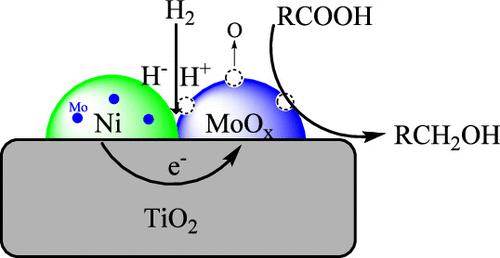揭示Mo掺杂Ni对催化脂肪酸加氢制脂肪醇的影响
IF 8.2
2区 材料科学
Q1 MATERIALS SCIENCE, MULTIDISCIPLINARY
引用次数: 0
摘要
脂肪酸加氢是生产脂肪醇的一种重要方法。镍和钼的结合是一种有效的低成本催化剂。然而,Mo掺杂的影响尚未完全了解。本文采用简单浸渍法制备了Ni-MoOx/TiO2催化剂。全面揭示了Mo掺杂的增强效应。首先,MoOx能从Ni中吸引电子,降低Ni的电子密度,提高Ni的本征活性,形成Niδ+-(MoOx)δ−异质结,诱导H2异裂生成活性氢离子。其次,MoOx的还原产生氧空位,可以吸收脂肪酸的C = O,促进反应的进行。第三,形成Ni1-xMox固溶体,增加了吸氢量,加快了反应速率。最后,发现Mo-O的结合强度是最优的,可以在释放醇的同时吸收脂肪酸,从而恢复氧空位,避免过氢化。因此,可以获得羧酸底物加氢成醇的高活性和选择性。在较温和的条件下(155℃,3 MPa H2),该催化剂能以40.1 kJ/mol的低活化能使月桂酸加氢产率达到98%。本研究为进一步了解Mo掺杂Ni对催化氢化反应的影响提供了新的思路。本文章由计算机程序翻译,如有差异,请以英文原文为准。

Revealing the Effects of Mo Doping to Ni on Catalyzing Hydrogenation of Fatty Acids to Fatty Alcohols
Fatty acid hydrogenation is an important method for the production of fatty alcohols. The combination of Ni and Mo has been reported to be an effective and low-cost catalyst. However, the effect of Mo doping has yet to be fully understood. Here Ni-MoOx/TiO2 catalysts were prepared via simple impregnation. and the enhancement effects of Mo doping were comprehensively revealed. First, MoOx can attract electrons from Ni, reduce the electron density of Ni to improve the intrinsic activity of Ni, and form a Niδ+-(MoOx)δ− heterojunction to induce H2 heterolytic cleavage to active hydrogen ions. Second, the reduction of MoOx generates oxygen vacancies, which can absorb C═O of the fatty acid and facilitate the reaction progression. Third, a Ni1–xMox solid solution can be formed, which can increase the hydrogen adsorption quantity and accelerate the reaction rate. Finally, the bond strength of Mo–O is found to be the most optimum that can absorb the fatty acids while releasing the alcohols so as to recover the oxygen vacancies and avoid overhydrogenation. Therefore, high activity and selectivity for the hydrogenation of carboxylic acid substrates to alcohols can be obtained. Under significantly milder conditions (155 °C, 3 MPa H2) the catalyst provided a 98% yield of lauryl alcohol from lauric acid hydrogenation with a low activation energy of 40.1 kJ/mol. This work could provide an insightful understanding about the effects of Mo doping to Ni on catalyzing hydrogenation reactions.
求助全文
通过发布文献求助,成功后即可免费获取论文全文。
去求助
来源期刊

ACS Applied Materials & Interfaces
工程技术-材料科学:综合
CiteScore
16.00
自引率
6.30%
发文量
4978
审稿时长
1.8 months
期刊介绍:
ACS Applied Materials & Interfaces is a leading interdisciplinary journal that brings together chemists, engineers, physicists, and biologists to explore the development and utilization of newly-discovered materials and interfacial processes for specific applications. Our journal has experienced remarkable growth since its establishment in 2009, both in terms of the number of articles published and the impact of the research showcased. We are proud to foster a truly global community, with the majority of published articles originating from outside the United States, reflecting the rapid growth of applied research worldwide.
 求助内容:
求助内容: 应助结果提醒方式:
应助结果提醒方式:


